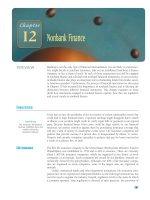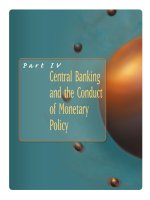Money banking and the financial system 1e by hubbard and OBrien chapter 01
Bạn đang xem bản rút gọn của tài liệu. Xem và tải ngay bản đầy đủ của tài liệu tại đây (378.38 KB, 38 trang )
R. GLENN
HUBBARD
ANTHONY PATRICK
O’BRIEN
Money,
Banking, and
the Financial
System
© 2012 Pearson Education, Inc. Publishing as Prentice Hall
CHAPTER
1
Introducing Money and the
Financial System
LEARNING OBJECTIVES
After studying this chapter, you should be able to:
1.1
Identify the key components of the financial system
1.2
Provide an overview of the financial crisis of 2007–2009
1.3
Explain the key issues and questions the financial crisis raises
© 2012 Pearson Education, Inc. Publishing as Prentice Hall
CHAPTER
1
Introducing Money and the
Financial System
CAN THE FED RESTORE THE FLOW OF MONEY?
•During the economic crisis that began in 2007, the financial system was
disrupted as it hadn’t been since the 1930s.
•Large sections of the U.S. economy were cut off from the flow of funds they
needed to thrive.
•Some government intervention was necessary to pull the economy out of a
deep recession.
•During the recession, more than 8 million jobs were lost, GM declared
bankruptcy, and some Wall Street investment houses disappeared.
•An Inside Look at Policy on page 20 reviews options the Fed considered to
support the economy in late 2010.
© 2012 Pearson Education, Inc. Publishing as Prentice Hall
Learning
1.1
Objective
Identify the key components of the financial system.
© 2012 Pearson Education, Inc. Publishing as Prentice Hall
4 of 38
Three major components of the financial system:
1. Financial assets
An asset is anything of value owned by a person or a firm.
A financial asset is an asset that represents a claim on someone else for a
payment.
2. Financial institutions
3. The Federal Reserve and other financial regulators
Key Components of the Financial System
© 2012 Pearson Education, Inc. Publishing as Prentice Hall
5 of 38
Financial Assets
Economists divide financial assets into those that are securities and those that
aren’t.
A security is a financial asset that can be bought and sold in a financial market.
Financial markets are places or channels for buying or selling stocks, bonds,
and other securities.
Key Components of the Financial System
© 2012 Pearson Education, Inc. Publishing as Prentice Hall
6 of 38
Financial Assets
Five key categories of financial assets:
1. Money
2. Stocks
3. Bonds
4. Foreign exchange
5. Securitized loans
Key Components of the Financial System
© 2012 Pearson Education, Inc. Publishing as Prentice Hall
7 of 38
Financial Assets
Money
Money Anything that is generally accepted in payment for goods and services
or to pay off debts.
The money supply is the total quantity of money in the economy.
Key Components of the Financial System
© 2012 Pearson Education, Inc. Publishing as Prentice Hall
8 of 38
Financial Assets
Stocks
Stocks are financial securities that represent partial ownership of a firm; also
called equities.
Dividend A payment that a corporation makes to its shareholders.
Key Components of the Financial System
© 2012 Pearson Education, Inc. Publishing as Prentice Hall
9 of 38
Financial Assets
Bonds
Bond A financial security issued by a corporation or a government that
represents a promise to repay a fixed amount of money.
Interest rate The cost of borrowing funds (or the payment for lending funds),
usually expressed as a percentage of the amount borrowed.
Key Components of the Financial System
© 2012 Pearson Education, Inc. Publishing as Prentice Hall
10 of 38
Financial Assets
Foreign Exchange
To buy foreign goods and services or foreign assets, a domestic business or a
domestic investor must first exchange domestic currency for foreign currency.
Foreign exchange Units of foreign currency.
Banks engage in foreign currency transactions on behalf of investors and
business firms.
Key Components of the Financial System
© 2012 Pearson Education, Inc. Publishing as Prentice Hall
11 of 38
Financial Assets
Securitized Loans
Before markets for loans were created, it wasn’t possible to sell loans. Loans
were financial assets but not securities.
Securitization The process of converting loans and other financial assets that
are not tradable into securities.
Note that what a saver views as a financial asset a borrower views as a
financial liability.
Financial liability A financial claim owed by a person or a firm.
Key Components of the Financial System
© 2012 Pearson Education, Inc. Publishing as Prentice Hall
12 of 38
Financial Institutions
• The financial system matches savers and borrowers through two channels:
(1) Banks and other financial intermediaries
Financial intermediary A financial firm, such as a bank, that borrows
funds from savers and lends them to borrowers.
(2) Financial markets
•
Funds flow from lenders to borrowers indirectly through financial
intermediaries, such as banks, or directly through financial markets, such
as the New York Stock Exchange.
Key Components of the Financial System
© 2012 Pearson Education, Inc. Publishing as Prentice Hall
13 of 38
Figure 1.1
Moving Funds Through the Financial System
The financial system transfers funds from savers to borrowers. Borrowers transfer
returns back to savers through the financial system. Savers and borrowers include
domestic and foreign households, businesses, and governments.•
Key Components of the Financial System
© 2012 Pearson Education, Inc. Publishing as Prentice Hall
14 of 38
Financial Institutions
Financial Intermediaries
Commercial bank A financial firm that serves as a financial intermediary by
taking in deposits and using them to make loans.
Households rely on borrowing money from banks to purchase “big ticket items.”
Firms rely on banks to meet their short- and long-term needs for credit.
Some financial intermediaries, such as savings and loans, savings banks, and
credit unions, are legally distinct from banks.
Key Components of the Financial System
© 2012 Pearson Education, Inc. Publishing as Prentice Hall
15 of 38
Making the Connection
Pawn Shop Finance: What Happens to Small Businesses
When Bank Lending Dries Up?
• Pawn shops typically make small loans at high interest rates.
• Before the financial crisis of 2007-2009, banks loosened lending
requirements. During the crisis, defaults by households and firms increased
dramatically.
• Loan losses during 2007–2009 were by far the largest since the Great
Depression of the 1930s.
• Many banks cut small businesses off from credit, forcing them to borrow
from pawn shops, family, or friends to operate.
Key Components of the Financial System
© 2012 Pearson Education, Inc. Publishing as Prentice Hall
16 of 38
Making the Connection
Pawn Shop Finance: What Happens to Small Businesses
When Bank Lending Dries Up?
Key Components of the Financial System
© 2012 Pearson Education, Inc. Publishing as Prentice Hall
17 of 38
Nonbank Financial Intermediaries
• Insurance companies
Insurance companies collect premiums from customers then invest the
premiums to obtain the funds necessary to pay claims and other costs.
• Pension funds
Pension funds invest contributions from workers and firms in stocks, bonds,
and mortgages to earn the money necessary to make pension benefit
payments.
Key Components of the Financial System
© 2012 Pearson Education, Inc. Publishing as Prentice Hall
18 of 38
Nonbank Financial Intermediaries
• Mutual funds
A mutual fund obtains money by selling shares to investors and invests the
money in a portfolio of financial assets.
Portfolio A collection of assets, such as stocks and bonds.
• Hedge funds
Hedge funds are similar to mutual funds but typically have no more than 99
wealthy investors and make riskier investments.
• Investment banks
Investment banks concentrate on providing advice to firms issuing stocks
and bonds or considering mergers with other firms.
Key Components of the Financial System
© 2012 Pearson Education, Inc. Publishing as Prentice Hall
19 of 38
Financial Markets
Financial markets are places or channels for buying and selling stocks, bonds,
and other securities.
Today, most securities trading takes place electronically between dealers linked
by computers and is referred to as “over-the-counter” trading.
Primary market A financial market in which stocks, bonds, and other securities
are sold for the first time.
Secondary market A financial market in which investors buy and sell existing
securities.
Key Components of the Financial System
© 2012 Pearson Education, Inc. Publishing as Prentice Hall
20 of 38
Making the Connection
What Do People Do With Their Savings?
Key Components of the Financial System
© 2012 Pearson Education, Inc. Publishing as Prentice Hall
21 of 38
The Federal Reserve and Other Financial Regulators
Federal agencies that regulate the financial system:
•Securities and Exchange Commission (SEC)
•The Federal Deposit Insurance Corporation (FDIC)
•Office of the Comptroller of the Currency
•The Federal Reserve System (the focus of this book)
Key Components of the Financial System
© 2012 Pearson Education, Inc. Publishing as Prentice Hall
22 of 38
What Is the Federal Reserve?
• The Federal Reserve is the central bank of the United States; usually
referred to as “the Fed.”
• Established by Congress in 1913 to deal with banking problems.
• Original role: Serve as a lender of last resort.
Key Components of the Financial System
© 2012 Pearson Education, Inc. Publishing as Prentice Hall
23 of 38
What Does the Federal Reserve Do?
• The Fed is responsible for monetary policy. Monetary policy refers to the
actions the Federal Reserve takes to manage the money supply and interest
rates to pursue macroeconomic policy objectives.
• The Fed is divided into 12 districts (See Figure 1.2).
• The main policymaking body of the Fed is the Federal Open Market
Committee (FOMC).
• Chair, Ben Bernanke from 2006 – present.
• The FOMC meets eight times per year. During these meetings, the Fed
decides on a target for the federal funds rate.
Federal funds rate The interest rate that banks charge each other on shortterm loans.
Key Components of the Financial System
© 2012 Pearson Education, Inc. Publishing as Prentice Hall
24 of 38
Figure 1.2 The Federal Reserve System
The Federal Reserve System is divided into 12 districts, each of which has a District
Bank located in the city shown on the map.•
Key Components of the Financial System
© 2012 Pearson Education, Inc. Publishing as Prentice Hall
25 of 38









